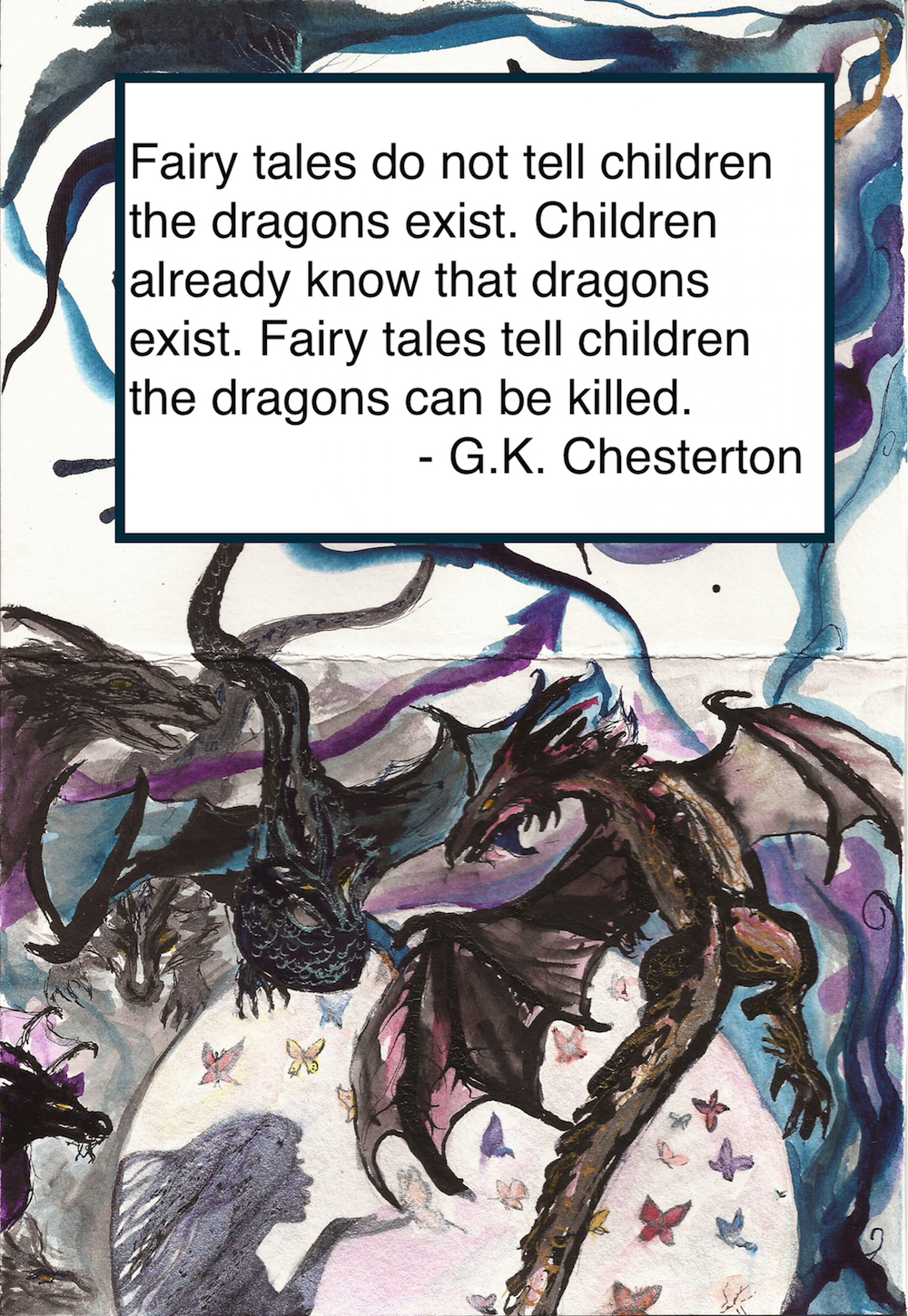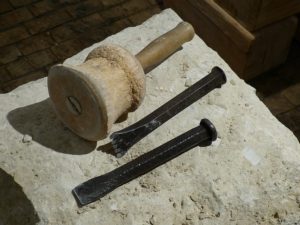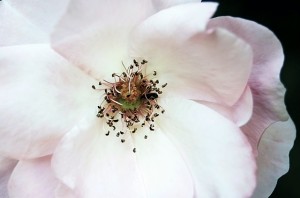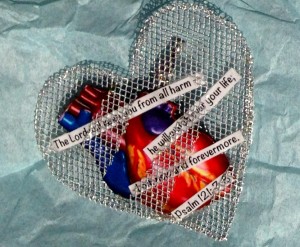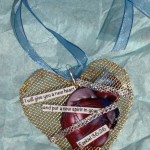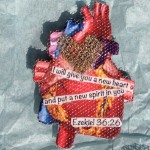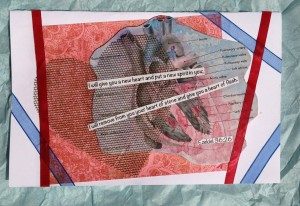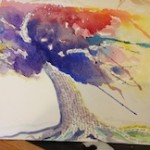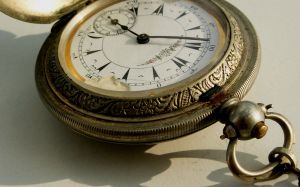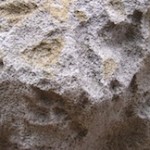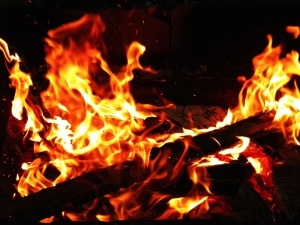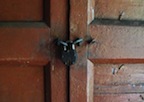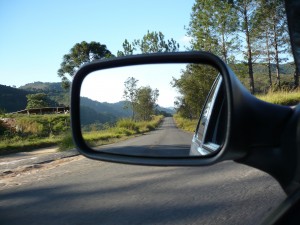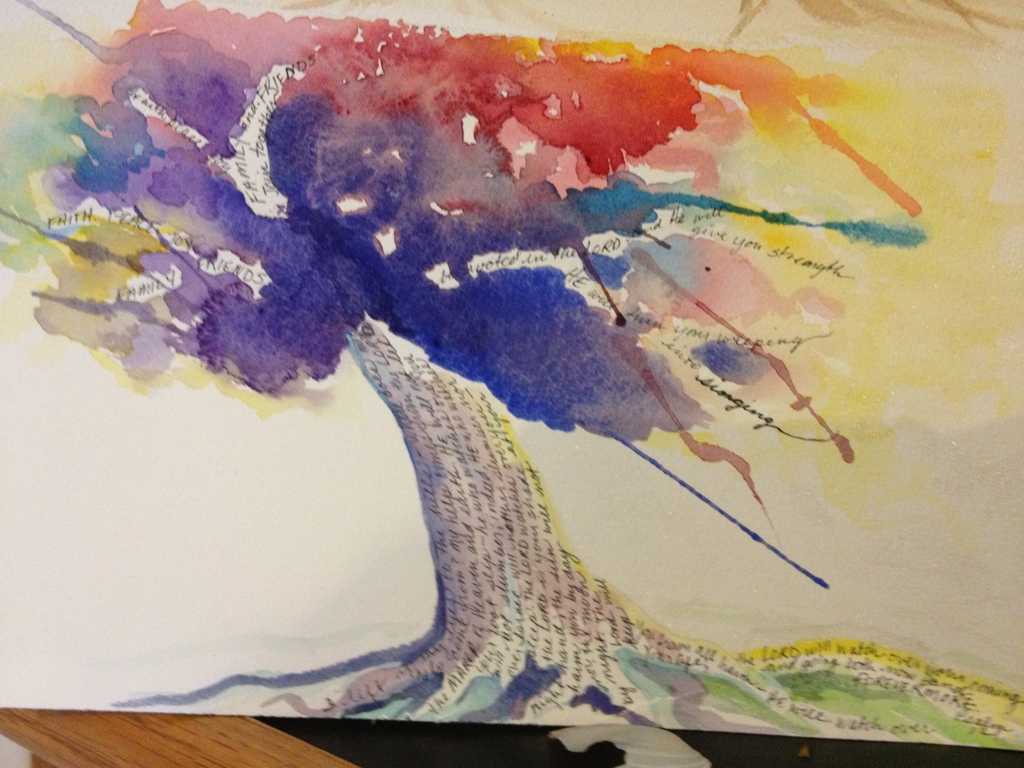Category Archives: Art
Day 13 – Poetry for Lent
Negative Space
The idea of negative space has intrigued me ever since I had an instructor talk about it in an art class. So much of art can be applied to life, don’t you think?
I think I’ll play around with light and dark font/background for this piece. It might add to the impact. And of course, the poem itself is rough, but I think there are some good seeds here….
You must add the darks,
my art teacher said
to balance the lights.
My darks creep in and
muddy my light
Negative space
my art teacher called it
The space that
surrounds an object
defines it boundaries
and finds its edges
Depression confines me,
cuts edges with razor blade steel
An object doesn't become real
my art teacher said
doesn't stand out
until you add shading.
What I am not
helps make what I am real
The mix of positive and negative space
my art teacher said
brings balance
to a composition.
Learning to think
in shades of gray
brings balance
to my life.
The Purpose of Fairy Tales
I painted the card for my niece and then found the quote in the front of the book The Story of Owen, Dragon Slayer of Trondheim, by E.K. Johnston. I loved the book — the world building and characters are unique. You should definitely get it from your library or nearest bookstore and read it. The sequel, Prairie Fire, came out and is on my pile of books to read. Can’t wait!
Where words and visuals meet
 When you write, do you see pictures in your head? Video? I remember one of my co-workers and a writer friend of mine, Mary Zitta, talking about how when she wrote, it was like a video playing in her head. She’d have her eyes closed, fingers dancing on the keyboard just trying to keep up.
When you write, do you see pictures in your head? Video? I remember one of my co-workers and a writer friend of mine, Mary Zitta, talking about how when she wrote, it was like a video playing in her head. She’d have her eyes closed, fingers dancing on the keyboard just trying to keep up.
That never happens to me. In fact, for the longest time I thought it meant I wasn’t really a writer. Most of the time when I write it is
like chipping away at stone. I know there’s something in there–although I’m not always sure even what it is. It is a matter of chipping away rock to reveal the story, the poem, the essay underneath. It’s hard work, not very exciting–and definitely labor intensive.
Of course, the longer I’ve been in the business of writing, the more I realize there many different ways to  write. Heather Sellers believes in writing slow — as in dipped-pen-in-ink slow. Some writers believe in writing fast — no revision until the whole thing is done (think NANOWRIMO). Some authors outline, some don’t. So while I no longer feel like my chipping-away-stone style of writing is wrong, I’m always searching
write. Heather Sellers believes in writing slow — as in dipped-pen-in-ink slow. Some writers believe in writing fast — no revision until the whole thing is done (think NANOWRIMO). Some authors outline, some don’t. So while I no longer feel like my chipping-away-stone style of writing is wrong, I’m always searching
to make it better. Faster would be nice too.
It took me some time to realize I DO visualize things. It just doesn’t tend to happen AS I write. Sometimes I get a picture in my head and then paint, draw, or WRITE to describe that visual in my mind’s eye.
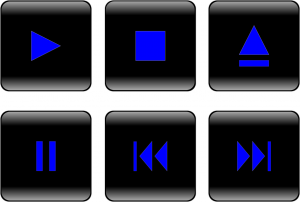 Sometimes the visual follows the words–like in foreign movies where the dubbing is off sync and the actor’s mouth moves after the words have been spoken. Even then it is a matter of rewinding and playing again as I try to get the visual right. So maybe for me, the visual comes more in the revision stage. In looking at the words on the page, and deliberately “seeing” the picture they create in my head. Does the picture match the scene, the emotions? If not, I revise. If so, I move on.
Sometimes the visual follows the words–like in foreign movies where the dubbing is off sync and the actor’s mouth moves after the words have been spoken. Even then it is a matter of rewinding and playing again as I try to get the visual right. So maybe for me, the visual comes more in the revision stage. In looking at the words on the page, and deliberately “seeing” the picture they create in my head. Does the picture match the scene, the emotions? If not, I revise. If so, I move on.
Since I have started dabbling in painting and drawing, I’ve found I can play up the visual to enhance the writing — and vice versa.
1. Sketch or storyboard a scene BEFORE you write it. (There are many different storyboarding tools. I’ve linked to Storyboard That which is a free tool.)
2. Pick some music fits the content or mood of what you are writing. Close your eyes and listen to it BEFORE you write. Pay attention to what images form in your head. When you write, play the music again. I create playlists for my novels–music or lyrics that fit with the plot and /or emotion of the piece. Not only do they help me sink into the writing stage, but also they help create images in my head as well as make me feel the emotion of the piece. (This makes sense if you think about it. Music soundtracks add to the tension/joy/sadness… of a movie.)
3. After you have written a scene, videotape yourself acting it out. Granted,  depending on the scene, you might want to make sure no one is around before you start. Acting it out helps not only with the movement in a scene (sometimes I find I’ve written something that just isn’t physically possible), but also with dialog. You’ll hear when the dialog isn’t working. Trust me. **Even if you don’t videotape it, it’s still worth acting it out.
depending on the scene, you might want to make sure no one is around before you start. Acting it out helps not only with the movement in a scene (sometimes I find I’ve written something that just isn’t physically possible), but also with dialog. You’ll hear when the dialog isn’t working. Trust me. **Even if you don’t videotape it, it’s still worth acting it out.
4. Draw your characters — or find them in magazines or real life. Does the picture you are looking at match the person you described?
5. Sketch/Storyboard the scene AFTER you have written it. You wrote it, can you “see” it enough to storyboard it?
6. When stuck for words, look for images. When stuck for a visual, play with words.
How about you? What is your style of writing–and what do you do to “enhance” it?
A small example from my writing practice: (keep in mind that I do not consider myself a poet. However, sometimes content choses form. But that’s another post.)
So, there’s a poem I’ve been monkeying with–not that I knew it was a poem when I started. It started with a visual–that of a loved one dying.
I spent the last few weeks in August helping give hospice care to my mother-in-law. Strange, sad, difficult, and wonderful days. Some of the hardest moments in my life–but something I was so blessed to be able to do. The stillness in her face held such a sense of… timelessness and urgency, waiting and great activity, all at the same time. The papery white cheeks, the breath–shallow and rapid–moving the ribcage up and down.
Those days stayed with me, and I needed to write about them–so I started with the visual of those last days.
wilted
wings limp, damp
heart beats
hummingbird fast
The word “wings” brought me another visual — that of a chrysalis. So I chipped away at that image.
moth pale skin
the minutes, days, years
wrap around
cocoon you waiting
for transformation
Looking at the words on the page, I kept seeing the chrysalis part of things, but not the becoming a butterfly part–not the transformation, beginning part. And when I was in that room, the warm golden light of the sun streaming in the window, Frank Sinatra crooning in the background — I had the sense of beginnings as well as endings.
Two weeks cocooned
now come and gone
and still breath
rises and falls
in its ribbed cage
eyes under thumbprint lids
move back and forth
seeing joys and sorrows
in the caterpillar past?
or dreaming of a winged future
soaring into the light
away from this inching physical form
How much longer
before full transformation?
released from this shell
spread your wings
and fly home
I’m not convinced it is there yet, but by going back and forth between the words and the visuals, I think it is getting closer to what I wanted it to express. Next, I want to paint it. Stay tuned!
5 Insights into the Creative Process
I finished an art project recently that made me realize that I have a rather messy creative process. Maybe everyone does, but I doubt everyone ends up with 6 finished pieces where they intended to make one. That would be what happened to me.
A friend of mine was going to have open-heart surgery and the surgeons were to put mesh around the values to strengthen them. I had an idea that I wanted to make something she could take with her–that would give hope. I knew I wanted to use the image of a real heart and mesh. It was also important to me to have a Bible verse on it as well. But how it was all going to go together… that part was a mystery.
After gathering all the components, I put together my first attempt. It wasn’t right. So I started another. Now, that’s not that weird. The strange part is that I didn’t give up on the first attempt either. Nor did I give up on the second attempt when I started a third. And so on and so forth.
In the end, I brought 6 finished pieces over to her house and had her pick which she liked. The whole experience gave me a few insights into my creation process that maybe could be applied to others as well.
1. Creating is non-linear.That doesn’t sound like a huge revelation, but I think often schools teach writing in this manner (and maybe art too, I’m just not in those classes as often). Rough draft, revision, peer-editing, revision, and polished piece. I have found the true
process to be a lot more back and forth and then slant and maybe even slant again. If I graphed the process, it would probably appear much more tangled than linear. My painting instructor once told me the difference between professional painter and beginners is not that they don’t make mistakes — it is that they work through their mistakes. (this was, of course, as she was helping me correct my mistake)
2. Creating is about persistence. I’m not saying one should never quit on a project, but if I quit on a project as soon as it wasn’t exactly what I expected/wanted, then I’d never complete anything–or discover the unexpected. Persistence, willingness to keep trying, changing, adapting, working at it, is (in my experience) much more important than inspiration.
3. Creating is about being willing to re-see and imagine anew. I started with an idea, but when that didn’t work out like I wanted, I had to imagine it a different way. Sometimes (often in my case) that takes time–and a willingness to try, play, fiddle–monkey around as my mother would have said.
4. Creating is about input. At one point I took my pieces (I only had 2 at that point) to work and showed a co-worker. I told her what I didn’t like about the piece–too big, maybe not feminine enough. She asked if I had tried a different kind of mesh. “Maybe tuele or lace or something.” When she brought some back after lunch, I started to see other possibilities. Getting input from writing groups, art groups, classes, books, lessons, videos, YouTube… can feed the creative process. I get why some people say you should never talk about your novel. If all you do is talk and not write, yup, it’s a problem. But I find that sometimes talking can feed the creative energy.
5. Creation is about trial and error. I didn’t get it right the first time. Or the second. Or the third. But I kept trying. I kept improving even those first, second, third attempts. Eventually, I came out with what I thought were some pretty cool art pieces (pins mostly, although one was a card and one you could hang somewhere.)
As I was thinking about writing this post, I did a little digging online and found this post from NPR on The Creative Process. It begins with a quote from Abigail Washburn (not that I have any idea who she is) that I find rings true.
“Is it an original idea? Or is it something where you’re literally a creative collagist? You’re taking pieces of the world that you see around you and that are inside of you, and put them together in a way that you see fit.”
Maybe it’s true that there is nothing new under the sun. Maybe we are all creative collagists. I like the idea that creating comes from the real world and from what’s inside and you put it together in ways that only you can.
So how about it, are you a creative collagist as well? And what does your creative process look like?
Celebration of ART
Today was the celebration of Peninsula Writers‘ Art-A-Day Challenge. The idea was to accept the challenge to be creative each day during the month. Through the use of Google Groups, participants posted their successes and challenges throughout the month. And today we all physically got together at Schuler Bookstore and presented
our efforts.
I almost didn’t go. After all, it was snowy and I didn’t really have a whole lot to show for the month. I’ve been revising every day, but that makes for poor showing. Imagine me saying, “Look, on January 21 I cut out an entire scene!” Yeah, not so exciting. Still, I’d done a little painting and more importantly, I wanted to support my fellow artists. So I harried my children into coming with me and we gathered up any of the “art” we’d done during the month and headed off to Schuler.
I’m glad I went. Not only was it inspiring to see what everyone had created, but it was affirming to me as an artist–and maybe even affirming as to the importance of art in our lives. People painted, glued, tangled, composed, sewed, scrapbooked, cooked gourmet meals, wrote, decorated a cast, created a collage, and thought–a lot–about art.
One of the things that struck me is how often these creative people mentioned the difficulty in finding time for art, and/or the doubts they experienced about their ability, about their creativity. I thought maybe it was just me. When it was my turn to share, I shared what I had learned about creativity from John Cleese. The fact that creative people take time and foster a sense of play was important reminder to me, being the sort of person who doesn’t believe in “wasting time.” I like to feel I have accomplished a lot in the day–and that means having something to show for it.
I also talked about learning that creativity is work. (see post) Not that I didn’t KNOW this,
but that someone recognized it and essentially said it was okay–normal even. Just because I don’t have story ideas flowing out of me at every turn doesn’t mean I’m not creative. What a relief! And the fact that sometimes writing feels like chipping away at stone doesn’t mean I shouldn’t write.
A little later one of the participants, Matt Bliton, mentioned listening to NPR’s On Being where Krista Tippett interviewed Brené Brown about her research on shame and how it affects creativity. Matt shared how often making ART is not seen as valuable. After all, some of us have JOBS. And he mentioned how Brené Brown said that this shame of not “producing” is especially hard on women. I can relate to this. It is hard for me to justify sitting and writing or painting when there are piles of dirty laundry and dinner to be made and kids to get in bed. The tyranny of the now is ever present, but we must remember to feed more than just our bodies.
So now I am home and January will soon come to an end, but the fire has been lit, and I will do my best to keep feeding it.
Unblocking — Lessons From One Medium to Another
Let the battle begin!
So I’m suited up for fighting dragons, my foot is in the stirrup (or my butt is in the chair in this case) but to be honest, I’m a bit rusty. I’m blocked. Stuck. I opened up my latest novel-in-progress, I Feel For You (IFFY in short form), and I wasn’t even sure where I had left off.
What to do, what to do. Well, even though I might be a slow learner, I do eventually get it, and when I do, I even manage to extrapolate to other situations. There are certain lessons I learned in my painting classes that I thought I might be able to use in the writing field, so here we go.
1. Get a different/broader perspective. This was extremely helpful for me in painting.
I’d come home from painting class not sure if I liked anything at all about what I’d painted. First thing I’d do is prop the painting up on our corner shelf and leave it there for a day or two, looking at it from a distance and in different lighting situations. Seeing the painting from a distance had a way of helping me pinpoint what was working and what wasn’t.
So how does this work for writing? Nope, I’m not talking about putting your computer screen so far away that you can’t read it anymore. Nor am I talking about throwing your pages down the basement steps.
- Print it out and read through the whole thing WITHOUT a pen in hand. For shorter pieces, chapters, or scenes, carry it with you throughout the day and read it several times. For novels, read it once without a pen and then a second time with the pen in hand.
- Record your piece of writing and then listen to it in the car (where you can’t jump in and start “fixing” words and sentences.) This is a great way to “hear it different.” I use Audacity to record (there are definitely other audio editor software you can use), then I save it in my iTunes, transfer it to my iPod and listen in my car on the way to and from work.
2. Use a different medium or tool. In painting that could be a different brush or
switching to a pen or some other type of paint. In writing, just switching from writing on the computer to writing on paper (or vise versa) can make a big difference. I’m older than dirt, so for me, computers feel more… serious, final, published. So sometimes when those dragons are loud and breathing fire down my neck, I find it easier to go back to writing on paper for awhile. After all, no big deal if I mess up there. I’m going to have to type it on the computer at some point anyway.
3. Don’t go for the masterpiece on the first try. This came about because the first time I took a painting class at Kendall, I had this idea I was going to come home with paintings I would want to hang on our walls. Needless to say, that didn’t happen. My husband noticed my disappointment and reminded me of how many times Monet painted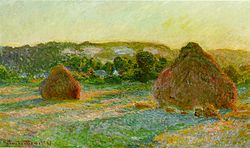 haystacks. “You can try it more than one time,” he said. Such a simple thought but oh so freeing. When it doesn’t have to be hang-worthy the first time, I felt free to try new things, to be bold, and to go for it. After all, I could always re-do it. Ironically enough, my painting improved enough I even considered hanging one up this year.
haystacks. “You can try it more than one time,” he said. Such a simple thought but oh so freeing. When it doesn’t have to be hang-worthy the first time, I felt free to try new things, to be bold, and to go for it. After all, I could always re-do it. Ironically enough, my painting improved enough I even considered hanging one up this year.
- Remember Anne Lamott’s advice in her book, Bird by Bird, about the Sh—- First Draft. Sloppy Copy.
 Whatever you call it, just go for it. Focus on the story, the character, the action–whatever the skill it is you want to try and remind yourself that this is just your first haystack in the series.
Whatever you call it, just go for it. Focus on the story, the character, the action–whatever the skill it is you want to try and remind yourself that this is just your first haystack in the series. - Make a mess–clean up later. Definitely works with paint. Works equally well with words.
4. Don’t get stuck in one area; keep moving around the page.This was a biggie for
me this past summer. I would be working on a painting and find myself getting really detailed in one area whereas I had pretty much ignored other parts of the picture. (It really, really bites when I find out what I spent all that time on doesn’t fit with the rest of the picture–which I would have known had I roughed in the whole thing first.) My instructor frequently had to come around and remind me to MOVE ON. Great advice for writing too.
- Keep moving. Don’t get stuck revising and adding all sort of detail on the first chapter (or first line). Move on. You will come back and add more detail after the whole page (manuscript) has been given a nice coat of words. And by then you might even know what those details ought to be.
5. Start. Anywhere. Now. Just start. As I learned in art class, you have to put paint on the
page. Just dive in and put some color on that white page. Works the same way with writing. Put a word on the page, and then another one. Who cares if it is the right word? Who cares if it is the “beginning” of the story? Just START.
So there you go–and here I go. Happy writing.
All images are from stock.xchng. Check it out.

